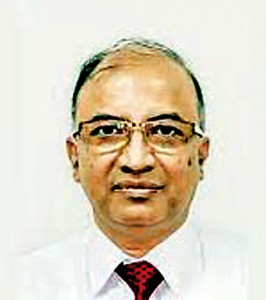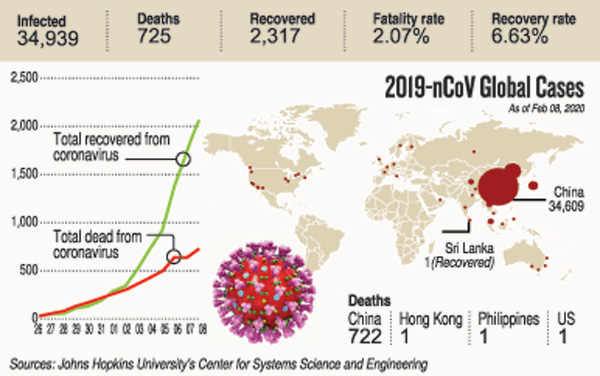News
Special measures in SL to be in place until ‘all clear’
Sri Lanka will keep in place all special precautionary and surveillance measures, until the infection spread by the new coronavirus abates abroad and the disease is brought under control, assured a high-level health official on Friday.

Dr. Anil Jasinghe

Dr. Hemantha Herath
“We will be extra-vigilant even after the last few patients – in Wuhan, China where the 2019-nCoV epidemic began – are all cleared,” the National Coordinator for Disaster Management at the Health Ministry, Dr. Hemantha Herath told the Sunday Times referring particularly to the measures put in place at the Bandaranaike International Airport (BIA), Katunayake.
Dr. Herath has been entrusted by the Director-General (DG) of Health Services, Dr. Anil Jasinghe, with the task of coordinating activities at the BIA to ensure that proper information is collected from all passengers arriving there, to facilitate effective surveillance by field staff who will then closely monitor them for any illness.
On Thursday, Health Minister Pavithra Wanniarachchi told a media briefing that the strong links with the World Health Organisation (WHO) further cemented through Dr. Jasinghe’s appointment in Geneva this week as the Vice Chairman of its Executive Board would help Sri Lanka provide better health care to its people.
With regard to the nCoV, the Minister said that even though day by day, the number of patients reported with the disease is increasing in China, especially in Wuhan, the steps that the Sri Lankan government has taken have helped to curb the number of Chinese coming into the country.
“Around 15,000 foreigners usually come to Sri Lanka through the BIA each day, but the numbers have now dropped to about 10,000. This decrease can be depicted as the drop in the number of Chinese coming into the country,” she said, pointing out that as of Wednesday only 46 Chinese had arrived.
Minister Wanniarachchi reiterated that the authorities were in constant touch with Chinese officials and they were able to take steps to minimise the spread of the virus, without harming the close relationship and friendship between Sri Lanka and China.
Director-General Dr. Jasinghe said that as of February 6, there were 16 ‘suspected’ cases. The National Institute for Infectious Diseases (NIID) has 3; Kandy National Hospital – 4; Negombo Hospital – 2; Karapitiya Teaching Hospital – 2; Ragama Teaching Hospital – 1; Gampaha Hospital – 1; Badulla Hospital – 1; Kurunegala Teaching Hospital – 1; and Jaffna Teaching Hospital – 1. 
“With indications that most of the people who have come back from abroad are in the areas of the Colombo Municipal Council, the Dehiwela-Mount Lavinia Municipal Council and Gampaha, I have instructed the Medical Officers of Health (MOHs) on the measures to be taken if those who have returned fall ill,” he said, adding that MOHs are also visiting construction sites where there are Chinese workers to see whether there is anyone who is ill.
Referring to the measures in place, Dr. Herath said that the DG had informed the DG of Civil Aviation to help ensure that the Health Declaration Forms of the Health Ministry are distributed among all passengers while on board, so that they could be duly filled before disembarkation and handed over to the health staff.
“We have sought the cooperation of all the airlines so that passengers face minimal inconvenience,” he said, adding that once they get off the aircraft, the passengers pass through three points where there are thermal scanners which would detect if anyone is having fever. These are the points at which the forms are also collected and if a passenger has not filled it, there are seats and desks where he/she can sit and do so.
The moment the form is handed over, the staff takes a quick look at the particular boxes indicating the health of the passenger and if ill will usher this passenger to the health office for further screening. If a person is really ill, and that would be occasionally, and the clinical picture points towards the new coronavirus, then he/she would be taken to one of the designated hospitals.
Underlining that all agencies including the Epidemiology Unit are working together, Dr. Herath showed some data on his phone similar to a disaster dashboard they had earlier.
“In China, there were a total of 31,472 affected by the nCoV. Of these patients, 638 have died and 1,553 have recovered and been discharged from hospital. As this is a new virus, there is a lot more information we need to gather. Even though the death rate is much lower than the Severe Acute Respiratory Syndrome (SARS), it seems to be taking a long time for people to recover from this illness. So, we need to be cautious until we establish all facts about this virus,” he said.
Dr. Herath pointed out that Sri Lanka was able to implement the initial response to the nCoV as the ministry’s Disaster Preparedness and Response Division had facilitated and the NIID had put in place certain measures. It already had Personal Protective Equipment (PPE), the health and ambulance staff had training and also undergone drills.
He commended that all the major hospitals have gone through disaster drills at least once a year. The aim should be for these drills to be held once in six months, in keeping with WHO Guidelines.
Meanwhile, other health sources also urged that Sri Lanka should be cautious as this is a new virus. Even when the patients have recovered in clinical terms, there is inadequate research yet whether the virus is still present in their bodies and whether they could still infect others.
“This seems why China is not discharging the patients affected by nCoV quickly and letting them get back into the community. It is good to be safe than sorry later,” the sources said.
Referring to the course of nCoV being unchartered territory, the sources also explained that there was no confirmed medication yet to treat it. Currently, it is management of symptoms and ensuring that any complications are handled immediately.
Usually anti-viral drugs are sensitive to some viruses but resistant to others and this is what the world is trying to find out in the case of nCoV, the sources added.




| Private hospitals and malls provide adequate hand-wash | |
| As health authorities kept stressing that the best way to ward off any upper respiratory illness would be to wash one’s hands thoroughly with soap and water and not touch the face, as viruses enter a person’s body through the mouth, nose and eyes, the Sunday Times checked not only private hospitals but also malls to see whether soap was available in toilets. All the main private hospitals and malls had hand-wash readily available in their washrooms. This is while the private hospitals also had an alcohol-based hand-sanitizer in public areas. One hospital had hand sanitizer outside its washrooms and hand-wash inside, while displaying a WHO poster in the washrooms on how to wash one’s hands. One mall also checked each and everyone entering it with a hand-held temperature sensor and another had posters about the new coronavirus in Sinhala, Tamil and English on its washroom walls. Just one mall, however, had more water than soap in its hand-wash dispensers in the toilets.  Hand-wash in the toilets of some private hospitals
 Hand-wash in a popular mall and information on the new coronavirus displayed in all three languages
|



